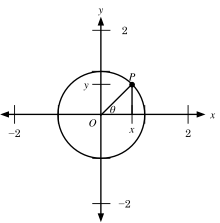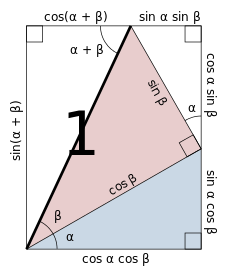Trigonometric functions play an important role in calculus. In many aspects, the trigonometry content you may review, if necessary, here will be fundamental in understanding certain operations in calculus. In other aspects, it may be necessary to understand the basic trigomentric lessons learned to understand certains proofs. The following information regarded below is more of a review rather than an intended lesson on the entire highschool subject of pre-calculus or even just trigonometry itself. There may be a WikiBook page that is of utmost importance to the new learner regarding trigonometry alone. For those learners, it is recommended for you to go back and learn trigonometry first before you find calculus daunting. For the learners who need a refresher, please read through the brief summary of the material you will need to know below to understand concepts in calculus better.
Basic trigonometric functions
The basic trigonometric functions are the sine, cosine and tangent functions. In mathematical expressions, these are represented as , and respectively. These functions relate the angles in a right triangle to various ratios of the lengths of the triangle's sides. You may recall the mnemonic SOH-CAH-TOA, which helps the student remember these relationships. Refer to the figure below. is the angle of interest, is the length of the side of the triangle opposite the angle, is the length of the side of the triangle adjacent to the angle, and is the length of the hypotenuse. The mnemonic tells us that , , and .
Measuring angles
_of_circle_with_center_theta_and_radius_R.svg.png)
In everyday life it is common to measure angles in degrees, where there are 360 degrees in a circle. In mathematics it is often convenient to use a different measure of angles, the radian. There are radians in a circle. Why is the radian used in math? It turns out that the radian is a natural measure of circles. Consider the circle in the figure to the right. is the radius, is an angle with vertex at the center of the circle, and is the arc of the circle subtended by the angle. By using radians as the measure for the equation holds. Certain operations we will study in calculus are simplified by using radians as the measure of angles.
Suppose you want to convert between radians and degrees. There are 180 degrees and radians in a half circle. Using the ratio of degrees to radians or radians to degrees in a half circle gives us a scaling factor to convert from radians to degrees or degrees to radians, respectively.
An example calculation below is used to find the measure of . Notice that is eliminated when multiplying the two dimensions.
An example calculation is used to find the measure of . Notice that and is eliminated when multiplying the two dimensions.
The unit circle

A circle with radius 1 is called a unit circle. Imagine a circle with center at the origin of a Cartesian coordinate system, and imagine a line segment drawn from the center to an arbitrary point on the circle. Call this point . Suppose we know the angle with the vertex at the origin, , one line segment lying on the positive -axis and one line segment passing through . We would like to know the coordinates of in terms of . Consider the triangle with one point at the origin, one point at , and one point on the intersection of the x-axis, where each point is intersected linearly. The triangle formed is a right triangle since the angle formed at the last point, between and , is formed from the intersection of perpendicular lines. We can use trigonometry to find the coordinates of . is the length of the leg adjacent to . We know that , where is the length of the adjacent leg and is the length of the hypotenuse. and , being the radius of the unit circle. Thus, . A similar argument shows that , so .
Other trigonometric functions
In addition to the basic trigonometric functions we have covered so far, there are three other trigonometric functions that we will see in our study of calculus, namely, the secant, cosecant, and cotangent functions, represented mathematically as , , and , respectively. These functions are simply the multiplicative inverses of the cosine, sine, and tangent functions, respectively.
Trigonometric identities
From the definitions of , , and , one can see that . Likewise, . We can derive some useful identities using the definitions of the trigonometric functions together with the Pythagorean theorem. Recall that, given a right triangle having sides of length and and hypotenuse of length , that . Suppose the angle opposite the leg length and the adjacent leg length is .
If we divide the above equation by and replace the resulting expressions with their multiplicative inverses where applicable, we immediately derive another useful identity, namely
Equally one may multiply through ,
Deriving the angle addition formulae for sine and cosine
